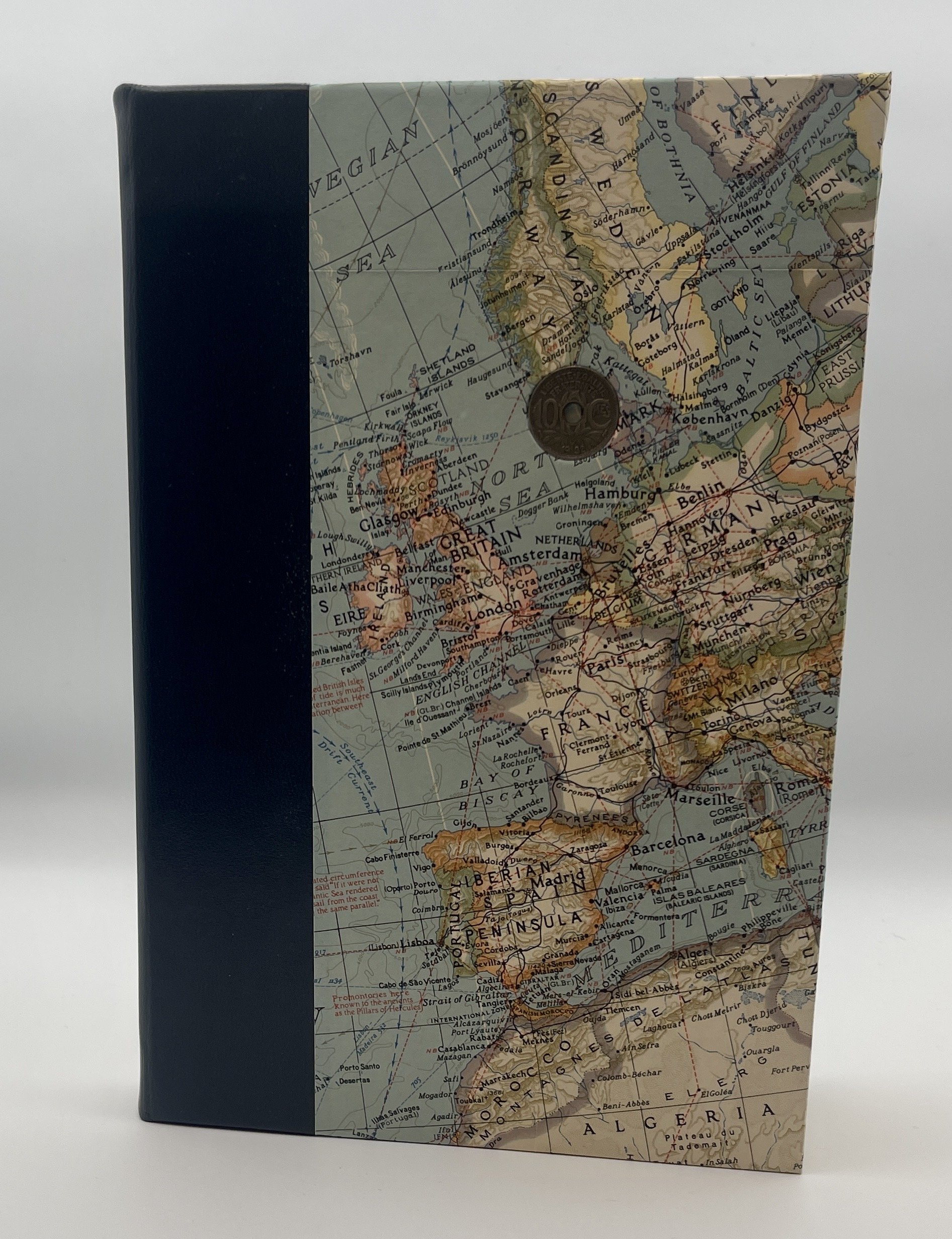Titania
This journal is made from cream-colored, 85 gsm Arches hand-laid, all cotton rag paper from France. It is sewn with Irish linen thread in the linked stitch pattern that was developed by the ancient Copts and discovered in Nag Hammadi, Egypt in 1945. This stitch allows the book to lay open at any page.
Its endbands are navy and gold silk, and its bookmark is goatskin. The spine is covered in hand-skived goatskin, and its boards are wrapped in a 1939 map showing Europe and French West Africa at the start of World War II. The map has been lightly conserved with a mulberry paper lining.
Treasure binding began with monks in the 6th Century who would encrust volumes with jewels. During the Renaissance, there was a resurgence in treasure binding. This is a contemporary revival of the treasure binding in which a lucky charm has been embedded in the cover of this book.
The talisman in this book is a 1932 vintage French 10 Centimes coin emblazoned with the French national motto “Liberty, Egalitie, Fraternite,” which the country adopted during the Age of Enlightenment.
This book is roughly 6.5 x 10” with more than 150 blank pages.
This journal is made from cream-colored, 85 gsm Arches hand-laid, all cotton rag paper from France. It is sewn with Irish linen thread in the linked stitch pattern that was developed by the ancient Copts and discovered in Nag Hammadi, Egypt in 1945. This stitch allows the book to lay open at any page.
Its endbands are navy and gold silk, and its bookmark is goatskin. The spine is covered in hand-skived goatskin, and its boards are wrapped in a 1939 map showing Europe and French West Africa at the start of World War II. The map has been lightly conserved with a mulberry paper lining.
Treasure binding began with monks in the 6th Century who would encrust volumes with jewels. During the Renaissance, there was a resurgence in treasure binding. This is a contemporary revival of the treasure binding in which a lucky charm has been embedded in the cover of this book.
The talisman in this book is a 1932 vintage French 10 Centimes coin emblazoned with the French national motto “Liberty, Egalitie, Fraternite,” which the country adopted during the Age of Enlightenment.
This book is roughly 6.5 x 10” with more than 150 blank pages.
This journal is made from cream-colored, 85 gsm Arches hand-laid, all cotton rag paper from France. It is sewn with Irish linen thread in the linked stitch pattern that was developed by the ancient Copts and discovered in Nag Hammadi, Egypt in 1945. This stitch allows the book to lay open at any page.
Its endbands are navy and gold silk, and its bookmark is goatskin. The spine is covered in hand-skived goatskin, and its boards are wrapped in a 1939 map showing Europe and French West Africa at the start of World War II. The map has been lightly conserved with a mulberry paper lining.
Treasure binding began with monks in the 6th Century who would encrust volumes with jewels. During the Renaissance, there was a resurgence in treasure binding. This is a contemporary revival of the treasure binding in which a lucky charm has been embedded in the cover of this book.
The talisman in this book is a 1932 vintage French 10 Centimes coin emblazoned with the French national motto “Liberty, Egalitie, Fraternite,” which the country adopted during the Age of Enlightenment.
This book is roughly 6.5 x 10” with more than 150 blank pages.






